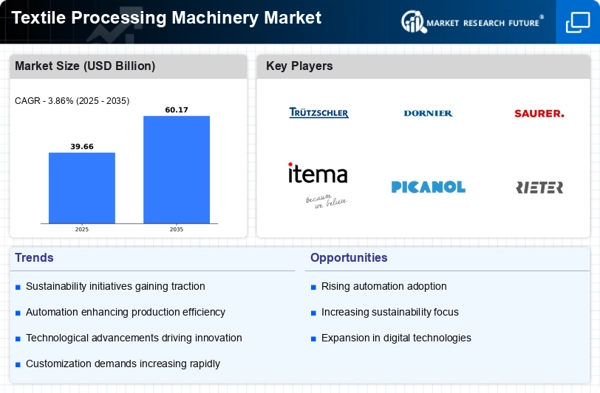Sustainability Initiatives
The Textile Processing Machinery Market is increasingly influenced by sustainability initiatives. Manufacturers are adopting eco-friendly practices to reduce waste and energy consumption. This shift is driven by consumer demand for sustainable products and regulatory pressures. For instance, the market for sustainable textile processing machinery is projected to grow at a compound annual growth rate of 8.5% from 2025 to 2030. Companies are investing in technologies that minimize water usage and utilize renewable energy sources. This trend not only enhances brand reputation but also aligns with global efforts to combat climate change. As a result, the industry is witnessing a transformation towards greener practices, which is likely to shape future investments and innovations.
Technological Advancements
Technological advancements are a crucial driver in the Textile Processing Machinery Market. Innovations in textile processing technologies, such as digital printing and advanced dyeing techniques, are reshaping production capabilities. These advancements enable manufacturers to produce high-quality textiles with reduced lead times and lower costs. The market for innovative textile processing machinery is anticipated to grow, with investments in R&D expected to increase by 15% annually. This focus on technology not only enhances product quality but also improves operational efficiency. As companies strive to stay competitive, the integration of cutting-edge technologies will likely play a significant role in shaping the future of the textile processing sector.
Customization and Flexibility
Customization and flexibility are becoming increasingly vital in the Textile Processing Machinery Market. As consumer preferences shift towards personalized products, manufacturers are compelled to adapt their machinery to accommodate diverse requirements. This trend is reflected in the growing demand for versatile processing equipment that can handle various fabric types and designs. The market for customizable textile processing machinery is projected to grow significantly, with an expected CAGR of 7% over the next five years. This adaptability not only enhances production efficiency but also allows companies to respond swiftly to market trends. As a result, the ability to offer tailored solutions is likely to become a key differentiator in the competitive textile processing landscape.
Automation and Smart Technologies
The integration of automation and smart technologies is a pivotal driver in the Textile Processing Machinery Market. The adoption of Industry 4.0 principles is revolutionizing production processes, enhancing efficiency and reducing operational costs. Advanced machinery equipped with IoT capabilities allows for real-time monitoring and predictive maintenance, which can lead to a reduction in downtime. According to recent estimates, the market for automated textile processing machinery is expected to reach USD 12 billion by 2026. This trend indicates a shift towards more intelligent manufacturing systems that can adapt to changing market demands. Consequently, companies that invest in automation are likely to gain a competitive edge in the evolving landscape of textile processing.
Rising Demand for Technical Textiles
The rising demand for technical textiles is significantly impacting the Textile Processing Machinery Market. Technical textiles, which are engineered for specific performance characteristics, are gaining traction across various sectors, including automotive, healthcare, and construction. This trend is driving the need for specialized processing machinery capable of handling advanced materials. The market for technical textile processing machinery is projected to expand, with an estimated growth rate of 6% over the next five years. As industries increasingly recognize the benefits of technical textiles, manufacturers are likely to invest in machinery that can meet these specialized requirements. This shift presents opportunities for innovation and growth within the textile processing machinery sector.


















Leave a Comment